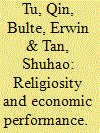| Srl | Item |
| 1 |
ID:
081898


|
|
|
|
|
| Publication |
2008.
|
| Summary/Abstract |
Using provincial data, the present paper examines the impact of cultivated land conversion on agriculture and the environment. It is found that the grain production center is gradually moving towards more fragile and water scarce areas, putting more pressure on the environment. Land conversion caused large losses in ecosystem service values in the 1990s, but large scale ecological restoration programs have been implemented since 2000 to compensate for such losses. The ecological restoration programs are concentrated in regions with relatively low land productivity, whereas cultivated land conversion usually takes place in areas with relatively high land productivity. Newly-cultivated land, especially that in areas marginally suit for agricultural production, is likely to have much lower productivity levels than the original cultivated land. Because the stock of potentially cultivable land is almost exhausted, China's grain self-sufficiency policy can only be maintained by preserving the available stock of arable land and increasing its productivity in a sustainable way
|
|
|
|
|
|
|
|
|
|
|
|
|
|
|
|
| 2 |
ID:
103908


|
|
|
|
|
| Publication |
2011.
|
| Summary/Abstract |
We use results from a household survey to explore the relation between religiosity and our proxy for income among herders in rural Tibet. Our main results are twofold. First, there exists a positive relation between the intensity of religious beliefs (the main 'output' of the religious production process) and income - beliefs about the afterlife affect production and savings decisions today. Second, and perhaps more surprising, we find an inverted U-shaped relation between religious 'inputs' (time and money spent in the temple) and income. While it is possible to use too much resources as religious inputs, we find that the great majority of the respondents is on the upward sloping part of the curve linking economic performance to religious inputs. We present tentative evidence that the positive impact of religiosity and income may be explained by status (reputation) and information effects associated with producing religiosity.
|
|
|
|
|
|
|
|
|
|
|
|
|
|
|
|